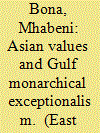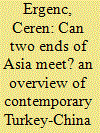|
|
|
Sort Order |
|
|
|
Items / Page
|
|
|
|
|
|
|
| Srl | Item |
| 1 |
ID:
145138


|
|
|
|
|
| Summary/Abstract |
Political elites in both the Arab Gulf and Asia have, in recent history, cultivated narratives that seek to legitimize their respective alternatives to the Western liberal-democratic model of government. In the Gulf Arab countries, this has involved highlighting the benevolence of the state through national myths of monarchical exceptionalism, while ruling elites on the Eastern side of the continent have employed the Asian values hypothesis to great effect. In both regions, exceptionalist discourses have boosted elite legitimacy in the aftermath of the Cold War – often by co-opting subaltern themes from postcolonial discourses. This study posits that the similarities between the two regional discourses are significant and that the potential is high for a future ideological convergence between them. Through its analysis of the Asia-Middle East Dialogue (AMED) – a 2004 Singaporean initiative to foster greater interregional dialogue between Eastern and Western Asia – it identifies three discursive frames that mark the existing discourse between elites on the Eastern and Western ends of the Asian continent. Focusing on the implications that these three frames would have if further adopted in Gulf Arab elite discourse, it suggests that the opportunity for discursive synergies is high as the Gulf Arab states continue to “Asianize” in the coming years.
|
|
|
|
|
|
|
|
|
|
|
|
|
|
|
|
| 2 |
ID:
145139


|
|
|
|
|
| Summary/Abstract |
China’s new Silk Road policy, titled “One Belt, One Road,” signals a proactive turn in China’s regional policy towards Central and West Asia. The policy has two dimensions: First, China aims to revitalize the old Silk Road exchange of goods, ideas, and people with trade, energy, and transportation projects. Second, armed with these new connections, China aims to redefine the territories the old Silk Road encompasses as a region in the contemporary international system. Turkey, as one of the countries at the westernmost end of the historic Silk Road, and one of the target countries of China’s new Silk Road diplomacy, welcomes the increasing economic and technological exchange with China. Establishing better contacts with China fits suitably in Turkey’s new foreign policy orientation. While the foreign policies of the two countries seem to be compatible, Turkish domestic political dynamics and public opinion hinder further engagement between the two ends of the Silk Road. The negative public opinion towards China manifests itself in the form of media coverage, protests and lobbying and, at times, it derails bilateral relations. This paper assesses the prospects for bilateral relations in the light of these developments. The paper starts with a historical analysis of Sino-Turkish relations and proceeds with various dimensions of the current relations. Then, it provides an analysis of various public opinion surveys in order to grasp the nature of the Turkish public opinion towards China, and it offers a media framing analysis in order to decipher the specific ways the image of China is constructed in Turkish public opinion. The last part of the paper discusses the domestic political actors that have a role in the perceptions and policies toward China in Turkey.
|
|
|
|
|
|
|
|
|
|
|
|
|
|
|
|
| 3 |
ID:
177209


|
|
|
|
|
| Summary/Abstract |
Global energy trade in hydrocarbons is being significantly re-oriented from the Atlantic basin to the Asia-Pacific region, with energy markets shifting their focus along the same patterns as the global economy –– towards the Asia-Pacific. The net result has been the centre of gravity of energy moving towards Asia and its large and emerging economies. The world is at the same time becoming a system of “world regions” and more urbanized, with the share of population of LDCs living in urban areas rising from 46% in 2014 to 57.9% in 2035. An emerging world region is arguably continental Asia in which East, Central, South and West Asia play a shaping part and developing its “Asianization”. It is argued here that economic orientation and urbanization trends will significantly impact global, and particularly Asian, energy markets thus determining the course of action of energy exporters of the GCC countries, and those of Central and West Asia. In Asia’s uneven energy markets, while China will lead energy demand growth in Asia in the 2020s, it will be India which likely will take up China’s mantle after 2025, thus maintaining and deepening the Persian Gulf’s “Asianization” and Asian energy interactions as part of a deeper integration of Asian economies.
|
|
|
|
|
|
|
|
|
|
|
|
|
|
|
|
|
|
|
|
|